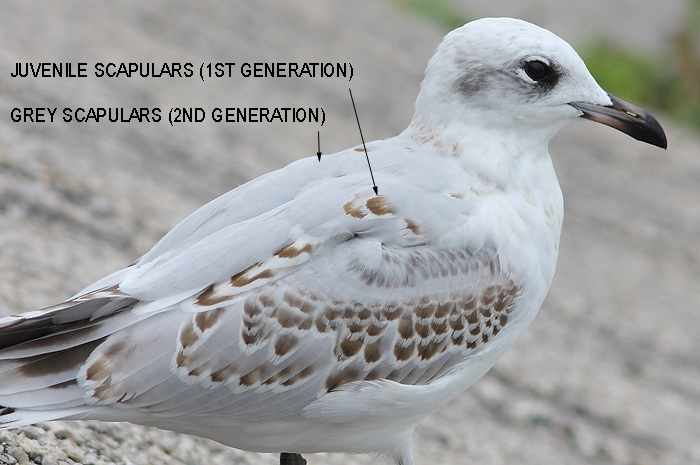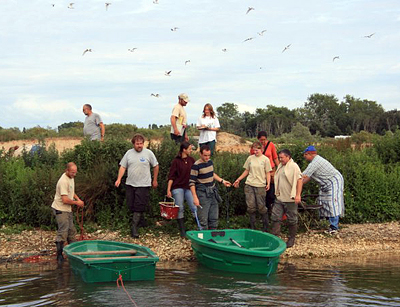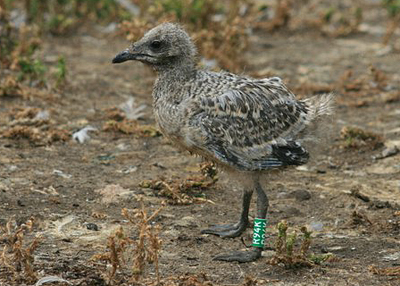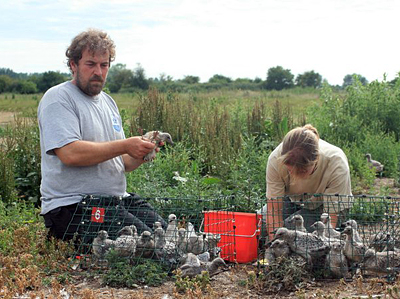 Mediterranean Gull (L. melanocephalus)
Mediterranean Gull (L. melanocephalus)
(last update: June 11, 2012)

Mediterranean Gull 1CY, August 2008. Picture: J.M. Sauvage.
Mediterranean Gulls used to breed in a restricted area in the countries north of the Mediterranean, the Black Sea and east to Dagestan. When Karel Voous wrote his Atlas of European Birds (1965) the distribution of this species was so limited that he suggested that it might be heading for extinction. Since the late 1980’s this species has spread north and the world population has increased spectacularly. It now breeds regularly in Belgium, the Netherlands, England, Ireland, Hungary and Poland. After the breeding season, Mediterranean Gull disperse westwards and can be found south along the Moroccan Atlantic coast and along the coasts of the Mediterranean. Large flocks congregate at the beaches of Boulogne-sur-Mer (NW France) from August to October, later moving southwards. In early spring tens of thousands can be seen at Cambrils on the north-eastern coast of Spain.
There are three distict periods to describe the presence and geographic distribution of Med Gulls in France:
1965-1975 In the Camargue, which is the only site for this species in France, a maximum of 2 couples raised chicks.
1976-1988 This colony gradually increased to 50 couples.
1989-1996 expansion up to 750 couples.
 Babin Island - Ukraine, craddle of the entire European population. |
Since the 1930s, the main Med Gull colonies were located in the N.P. Chernomorskyi Tendra Bay (Black Sea) on the northwest coast of the Black Sea in the south-western Ukraine. Since the 1970's, this reserve hosted almost all of the world population of the species. After reaching a maximum of 336.000 pairs in 1983, the population of the Bay of Tendra fluctuated extremely. The current population is at a much lower level with 60.000 pairs in 1994.
International situation: The origin of the species were long edges of marshes along the Black Sea. The species was threatened with extinction after the war, with only 6200 pairs in 1952. What followed can only be described as an explosion of the population, with already 42.000 pairs in 1957 and 336.000 in 1985. The species arrived in Hungary in 1940 and also in Austria; the Netherlands in 1959; Belgium in 1964; Britain in 1968; Italy in 1978; and Spain in 1987.
Source: Proceedings of the 1st international meeting on mediterranean gull, Le-Portel, Pas de Calais, France, 4-7 September 1998.
Most images on this page were taken at Le Portel / Boulogne-sur-Mer, France (50.42. 20 N,01.34.03 E). Le Portel is known to be one of the best sites to see Mediterranean Gulls with numbers exceeding 3.000 individuals during some autumns. As can be seen in the images, many individuals are colour ringed or metal ringed, and come from Mediterranean Gull populations from all over Europe. Colour-ringing Mediterranean Gulls started in The Netherlands in 1989 with only a handful of birds. Twenty years on thousands of birds have been colour-ringed and at the start of 2008 there are tens of projects all over Europe.
Mediterranean Gull is a medium sized gull, with an intense black head in adult summer and rather pale grey upper-parts. Easy clues for identification and ageing in Mediterranean Gull are the median coverts and outer primaries. Most of the description below follows P.J. Grant: "Gulls, a guide to identification".
1CY MEDITERRANEAN GULL
|
In juvenile plumage, the head is uniform pale buffish-brown with slightly darker ear-coverts and a pale throat. Juvenile birds have a blackish smudge in front of the eye and white crescents above and below the eye. The brown colour of the head extends onto the neck, forming a barred collar running down along the sides of the breast to the flanks. The under-parts and rump are white. The scapulars and mantle feathers are deep brown with an inconspicuous dark sub-terminal band and a silvery-white fringe, creating a scaly pattern.
The pattern of the scapulars is repeated on the lesser coverts, lower lesser coverts, median coverts, inner three to four greater coverts and upper tertials which also show brown centres and neat silvery-white fringes. They contrast strongly with the central and outer greater coverts, which are predominantly grey, forming a pale bar in the dark inner-wing in flight, as the secondaries are dark blackish-centred as well (but with broad white tips). The inner primaries are largely white-grey, the grey slightly decreasing in the primaries outwards, reduced to parts of the inner-webs in the outer primaries P9 and P10. The under-wing coverts are all-white, but there are neat black tips on the under-wing greater primary coverts. The white tail has a clear-cut black sub-terminal band, widest on t1-2, very thin on the outer rectrices (t6 can be completely white). The iris is dark brown, the legs are usually very dark horn, the bill is blackish.
The complete juvenile plumage lasts for only a short period in Mediterranean Gulls as they start to moult soon after fledging. This post-juvenile moult is a partial moult into so-called "first winter" plumage that starts from the moment the birds leave their colonies in July and will be finished by late September. This moult includes most of the head and body feathers. The head and under-parts become almost completely white, with a dark mask of variable size and intensity behind the eye extending as very narrow streaks over the nape. The eye-crescents are white and the dark smudge in front of the eye contrasts more than in full juvenile plumage. The second generation wing-coverts, mantle and scapular feathers are plain pale grey. The rich brown centres of the juvenile wing-covert centres bleach to a foxy brown and the white fringes quickly wear away. In most birds at least some wing-coverts are included in the post-juvenile moult. The extent of this covert moult is variable, in a few birds nearly all are moulted, in others all juvenile coverts are retained until the next complete moult that starts in May of the next year. All juvenile feathers show wear by September, contrasting with the recently moulted second generation feathers. The base of the bill starts to turn paler and the legs turn slightly paler as well.
Note that the comments on moult are based on observations of juveniles from and in Western Europe. More easterly fledged Mediterranean Gulls may postpone their moult to first winter until later in the autumn and very fresh looking juveniles may be encountered well into October.
2CY MEDITERRANEAN GULL
The next moult in Mediterranean Gull is again a partial moult, from February to April and includes body and head resulting in a so-called "first summer" plumage. Most noticeable is the replacement of head feathers: the head becomes much darker with some birds developing a full hood, but many only have some black flecking. The remiges and rectrices remain juvenile and by April have become bleached and abraded. Some individuals include inner wing-coverts in this partial moult, but the juvenile outer wing-coverts are retained and therefore very abraded. The colour of bare parts become more adult-like, with the bill-base turning paler red-orange. Most birds have extensive black on the bill tip, most prominent on the lower mandible. This is the most variable plumage in Med Gull since the appearance of 2cy birds depends on the combination of the extent of the post-juvenile moult, and bleaching and wear in the winter quarters.
From May to September, the first complete moult takes place, into so-called "second winter" plumage. The head pattern resembles the pattern in first winter birds, with a blackish mask behind the eye. The mantle, scapulars, tertials and all wing-coverts are replaced with plain pearl-grey feathers. The secondaries are as in adult birds, pale grey with a white tip. The second generation primaries are much paler than the first juvenile primaries, but still not nearly all-white as in adults. After finishing this complete moult a 2cy Mediterranean Gull in autumn has a diagnostic wing-tip pattern with a variable amount of black on P5-P10. P5 has only a small black sub-terminal spot, becoming gradually larger on the outer primaries as the black patch "eats up" the white along the edge of the outer-web, most prominent on P9-P10. In some birds, the outer greater primary coverts and rarely the alula coverts may show dark markings as well. The bill is orangey-red with a dark sub-terminal band. The legs are dull red or more obvious orangey-red. As with 2cy birds there is individual variation in this age group but it is less pronounced and mostly involves the amount of black in the outer primaries and the colour of the bill.
Biometry (measurements in mm’s) wing: 282-311, tail: 113-127, bill: 31-38, tarsus: 48-58; n = 21 (Dwight, 1925).
 Mediterranean Gull juvenile, July 28 2001, Le Portel, France.
Mediterranean Gull juvenile, July 28 2001, Le Portel, France. Mediterranean Gull juvenile H41 July 28 2001, Le Portel, France.
Mediterranean Gull juvenile H41 July 28 2001, Le Portel, France. Mediterranean Gull juvenile 3KR2 August 08 2003, Le Portel, France.
Mediterranean Gull juvenile 3KR2 August 08 2003, Le Portel, France. Mediterranean Gull juvenile, August 08 2003, Le Portel, France.
Mediterranean Gull juvenile, August 08 2003, Le Portel, France. Mediterranean Gull juvenile A8M August 08 2003, Le Portel, France.
Mediterranean Gull juvenile A8M August 08 2003, Le Portel, France. Mediterranean Gull juvenile, August 09 2003, Le Portel, France. 3 images.
Mediterranean Gull juvenile, August 09 2003, Le Portel, France. 3 images. Mediterranean Gull juveniles, August 09 2003, Le Portel, France.
Mediterranean Gull juveniles, August 09 2003, Le Portel, France. Mediterranean Gull juvenile, August 03 2006, Le Portel, France.
Mediterranean Gull juvenile, August 03 2006, Le Portel, France. Mediterranean Gull 1cy YHL1 August 07 2009, Le Portel / Boulogne-sur-Mer, NW France. Picture: Jean-Michel Sauvage.
Mediterranean Gull 1cy YHL1 August 07 2009, Le Portel / Boulogne-sur-Mer, NW France. Picture: Jean-Michel Sauvage. Mediterranean Gull juvenile P37 August 09 2003, Le Portel, France.
Mediterranean Gull juvenile P37 August 09 2003, Le Portel, France. Mediterranean Gull juvenile 3KN6 August 09 2003, Le Portel, France.
Mediterranean Gull juvenile 3KN6 August 09 2003, Le Portel, France. Mediterranean Gull 1cy PJL7 August 09 2009, Le Portel / Boulogne-sur-Mer, NW France. Picture: Jean-Michel Sauvage.
Mediterranean Gull 1cy PJL7 August 09 2009, Le Portel / Boulogne-sur-Mer, NW France. Picture: Jean-Michel Sauvage. Mediterranean Gull 1cy HY96 August 10 2009, Le Portel / Boulogne-sur-Mer, NW France. Picture: Jean-Michel Sauvage.
Mediterranean Gull 1cy HY96 August 10 2009, Le Portel / Boulogne-sur-Mer, NW France. Picture: Jean-Michel Sauvage. Mediterranean Gull 1cy YHP4 August 10 2009, Le Portel / Boulogne-sur-Mer, NW France. Picture: Jean-Michel Sauvage.
Mediterranean Gull 1cy YHP4 August 10 2009, Le Portel / Boulogne-sur-Mer, NW France. Picture: Jean-Michel Sauvage. Mediterranean Gull 1cy HTK6 August 12 2007, Le Portel / Boulogne-sur-Mer, NW France. Picture: Jean-Michel Sauvage.
Mediterranean Gull 1cy HTK6 August 12 2007, Le Portel / Boulogne-sur-Mer, NW France. Picture: Jean-Michel Sauvage. Mediterranean Gull 1cy H4L1 August 13 2014, Le Portel, NW France. Picture: Jean-Michel Sauvage.
Mediterranean Gull 1cy H4L1 August 13 2014, Le Portel, NW France. Picture: Jean-Michel Sauvage. Mediterranean Gull 1cy HE04 August 25 2009, Le Portel / Boulogne-sur-Mer, NW France. Picture: Jean-Michel Sauvage.
Mediterranean Gull 1cy HE04 August 25 2009, Le Portel / Boulogne-sur-Mer, NW France. Picture: Jean-Michel Sauvage. Mediterranean Gull 1cy HE31 August 25 2009, Le Portel / Boulogne-sur-Mer, NW France. Picture: Jean-Michel Sauvage.
Mediterranean Gull 1cy HE31 August 25 2009, Le Portel / Boulogne-sur-Mer, NW France. Picture: Jean-Michel Sauvage. Mediterranean Gull 1cy YHP4 August 25 2009, Le Portel / Boulogne-sur-Mer, NW France. Picture: Jean-Michel Sauvage.
Mediterranean Gull 1cy YHP4 August 25 2009, Le Portel / Boulogne-sur-Mer, NW France. Picture: Jean-Michel Sauvage. Mediterranean Gull 1cy-3cy 32E0 August 2008-2010, Le Portel / Boulogne-sur-Mer, NW France. Picture: Jean-Michel Sauvage.
Mediterranean Gull 1cy-3cy 32E0 August 2008-2010, Le Portel / Boulogne-sur-Mer, NW France. Picture: Jean-Michel Sauvage. Mediterranean Gull 1cy PHN5 September 09 2007, Le Portel / Boulogne-sur-Mer, NW France. Picture: Jean-Michel Sauvage.
Mediterranean Gull 1cy PHN5 September 09 2007, Le Portel / Boulogne-sur-Mer, NW France. Picture: Jean-Michel Sauvage. Mediterranean Gull 1cy 3L62 & 3L81 September 17 2005, Le Portel, France.
Mediterranean Gull 1cy 3L62 & 3L81 September 17 2005, Le Portel, France. Mediterranean Gull 1cy PHU3 September 23 2007, Le Portel / Boulogne-sur-Mer, NW France. Picture: Jean-Michel Sauvage.
Mediterranean Gull 1cy PHU3 September 23 2007, Le Portel / Boulogne-sur-Mer, NW France. Picture: Jean-Michel Sauvage. Mediterranean Gull 1cy PHU1 September 29 2007, Le Portel / Boulogne-sur-Mer, NW France. Picture: Jean-Michel Sauvage.
Mediterranean Gull 1cy PHU1 September 29 2007, Le Portel / Boulogne-sur-Mer, NW France. Picture: Jean-Michel Sauvage. Mediterranean Gull 1cy HFF7 October 16 2007, Le Portel / Boulogne-sur-Mer, NW France. Picture: Jean-Michel Sauvage.
Mediterranean Gull 1cy HFF7 October 16 2007, Le Portel / Boulogne-sur-Mer, NW France. Picture: Jean-Michel Sauvage. Mediterranean Gull H2T4 1CY, October 18 2014, Le-Portel, NW France. Picture: Jean-Michel Sauvage.
Mediterranean Gull H2T4 1CY, October 18 2014, Le-Portel, NW France. Picture: Jean-Michel Sauvage. Mediterranean Gull 1cy YHP5 November 30 2009, Le Portel / Boulogne-sur-Mer, NW France. Picture: Jean-Michel Sauvage.
Mediterranean Gull 1cy YHP5 November 30 2009, Le Portel / Boulogne-sur-Mer, NW France. Picture: Jean-Michel Sauvage.

